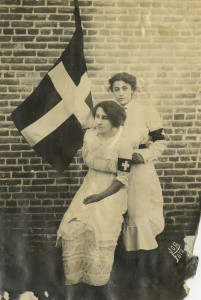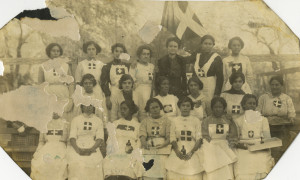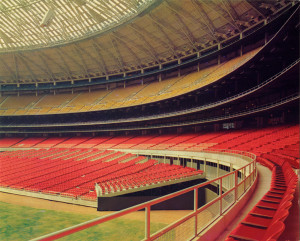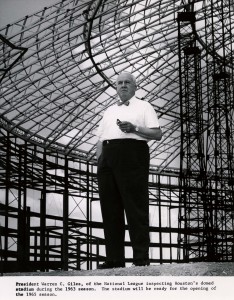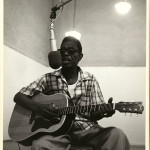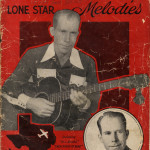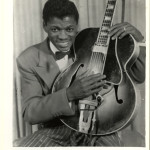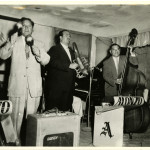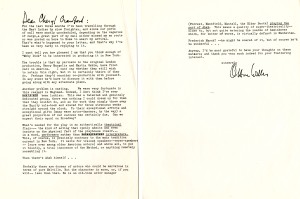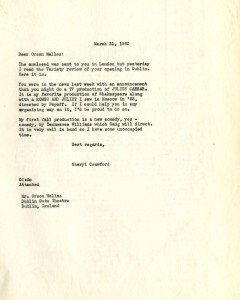
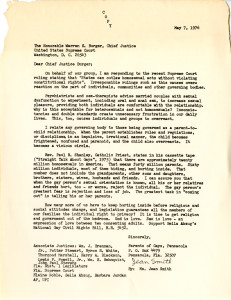
letter from Parents of Gays, Pensacola, FL to Chief Justice Warren Burger, regarding 1976 Supreme Court ruling upholding state sodomy laws that outlaw homosexual acts
Pride Week is upon us y’all and, like everything else in Texas, we do things a little bigger in Houston.
Now, with one more reason to celebrate, hundreds of thousands of Houstonians will defy our grinding heat and humidity, jamming the streets and locales of Montrose in celebration of Pride Week. For more than 34 years Pride Houston has played a central role in coordinating this massive undertaking and the volunteers needed to make it the success it is every year. About a decade after Stonewall, the LGBT community in Houston joined with others around the world to mark the anniversary of this crucial turning point in the movement for equal rights. Houston held its first celebration in 1979 and has been going strong since.
Saturday, June 29th marks the fever pitch of the week’s events. A festival leading up to the parade, featuring exhibits and entertainment, will begin at 1pm on Saturday. The parade will follow at 8pm (or shortly thereafter) when Houstonians will pack the parade’s route along Westheimer to show the city’s support of the LGBT community and celebrate like no other evening of the year.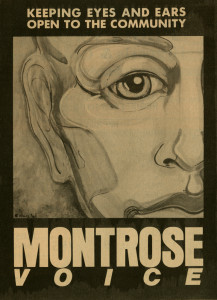
We would like to encourage everyone to drop by the History Tent during the festival leading up to the parade. Staffed by volunteers, including librarians and archivists representing a number of institutions here in Houston, the Pride Houston History Tent will showcase a number of items outlining the history of the LGBT community in Houston and beyond. Our own Vince Lee, Archivist for the Carey C. Shuart Women’s Archive and Research Collection, will be present with materials from the Hazelwitch Productions Inc. Records, the Annise Parker Papers, and gay and lesbian materials and ephemera from the Houston Area NOW and Other Feminist Activities Collection. In addition, Vince plans to showcase works from our Norma J. Lee Lesbian & Feminist Collection and Edward Lukasek Gay Studies Collection.
Feeling the Pride this week (or any other)? Thanks to the efforts and generosity of so many, the Carey C. Shuart Women’s Archive and Research Collection has grown into a hub for research relating to the LGBT community in the Houston area and far beyond. The materials listed above, as well as others, remind scholars that they would do well to make this a first stop when conducting related research.
Leonor Villegas de Magnón earned five medals for her service during the Mexican Revolution. What makes this unlikely war hero even more remarkable is that much of that service during the war came north of the Rio Grande. Born in Nuevo Laredo, Mexico and educated in the United States, Magnón made her life in the U.S. as fighting engulfed the competing factions to the south. A teacher by trade, her stake in history would come as a journalist and activist in the Mexican Revolution with her formation of La Cruz Blanca.
As the fighting of the Mexican Revolution butted against the border of Texas in the city of Laredo, Magnón crossed the border to help provide medical assistance to the wounded and eventually converted her home and adjoining facilities into a makeshift wartime hospital. This organization, cobbled together by Magnón in the crucible of war, became known as La Cruz Blanca and provided medical assistance to the wounded regardless of their political leanings. Despite her attempts at establishing the neutrality of La Cruz Blanca, she still found herself under scrutiny from American army officials wary of violations of neutrality. Smuggling soldiers in and out for medical care became a danger in and of itself as soldiers caught crossing the border were often detained and taken into custody by the U.S. Army.
The Leonor Villegas de Magnón Papers include original ledgers and documents related to the organization and operation of La Cruz Blanca. In addition, this collection holds personal documents, writings, photographs, as well as original documents and manuscripts related to her autobiographical work The Lady was a Rebel (or La Rebelde). Forward-thinking, Magnón handled her own translations, penning both the English and Spanish language tale of her life and the critical role of La Cruz Blanca. Both versions of this novel are published by Arte Público Press.
Do take the time to look through the detailed finding aid to see what other gems might be found and come visit us when you are ready to take a longer look at a truly revolutionary woman.
Today the National Trust for Historic Preservation released its 26th annual list of America’s 11 Most Endangered Places, and guess who made the list.
For Astrodome preservationists, the announcement comes not a moment too soon.
Just a few months ago NFL Commissioner Roger Goodell started rattling the wrecking balls, suggesting it would enhance Houston’s chances of hosting the 2017 Super Bowl should the Astrodome be demolished noting, “Whether it’s more parking, whether we can have more events there on that space — it’s not just the stadium itself, it’s the area surrounding it that’s valuable. And, I think that could be a very positive change in their Super Bowl bid.” (Footnote: Houston was later awarded the bid with no definite word on the future of the Dome.)
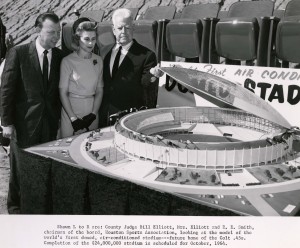 So, naturally, the threat of the Dome’s demise has many waxing nostalgic, including yours truly, and finds me digging through the George Kirksey Papers. Kirksey, along with Roy Hofheinz and others, was instrumental in bringing Major League Baseball to Houston. The scope of his papers, held here at the University of Houston Special Collections, extends beyond baseball, but they do contain some real photographic gems from the Dome’s design, groundbreaking, and through its golden era (some included here).
So, naturally, the threat of the Dome’s demise has many waxing nostalgic, including yours truly, and finds me digging through the George Kirksey Papers. Kirksey, along with Roy Hofheinz and others, was instrumental in bringing Major League Baseball to Houston. The scope of his papers, held here at the University of Houston Special Collections, extends beyond baseball, but they do contain some real photographic gems from the Dome’s design, groundbreaking, and through its golden era (some included here).
Goodell was right about the Astrodome and the land it is on being valuable. It is just that not everything can be calculated via a return-on-investment spreadsheet, and the true value of the Astrodome, standing in some form or another, is beyond mere value as we understand it these days in Houston.
Reading the tea leaves of the Dome’s future is an exercise in futility and frustration. However, it is encouraging to see Mayor Parker express interest in preservation ideas akin to the master’s project of UH’s own Ryan Slattery, but the future of the Dome is still in doubt.
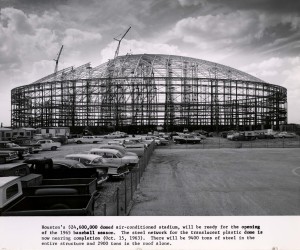 Whatever becomes of it, there is not much that can be said here that has not already been captured by a number of impassioned pleas, linking Houston’s sporting history to that of the Astrodome’s timeline. However, for those who are not sports fans or who did not make memories in this grand experiment of a stadium, let us set aside the history of the Astros, the Oilers, the Houston Livestock Show and Rodeo, the Game of the Century, the Battle of the Sexes, et al. The Astrodome speaks to something larger.
Whatever becomes of it, there is not much that can be said here that has not already been captured by a number of impassioned pleas, linking Houston’s sporting history to that of the Astrodome’s timeline. However, for those who are not sports fans or who did not make memories in this grand experiment of a stadium, let us set aside the history of the Astros, the Oilers, the Houston Livestock Show and Rodeo, the Game of the Century, the Battle of the Sexes, et al. The Astrodome speaks to something larger.
That this audacious figment of our collective imagination (No mosquitoes? Air-conditioned baseball in Houston?!) could be brought into being, transcends the idea or concept of a niche sporting audience and speaks to us not solely in terms of sport. It speaks, perhaps, more in terms of our ingenuity, our desire to always overcome and produce that which seems futile or silly and, admittedly, to do so in ways that may see the execution of it all fall short of our lofty, futuristic visions.
So, there it was built and there it stands, as a monument to all that is comical and wonderful and, yes, endearing about us. It remains a symbol of our moonshot in an era where the Moon seemed suddenly within reach.
Driving by the Astrodome at night, even dwarfed as it is by the sterile Reliant Stadium, it seems to grumble, “We are the masters of our domain. We will control the environment on a massive scale, and we will restore novelty to the novel, creating a spectacle of sport again. We will always figure out how to manifest our yearning in ways that are bigger and infinitely more ingenious, for better or for worse.”
A little hubris, there? Perhaps. But, then, all the more reason to retain it as a reminder. Either as an albatross or our Eiffel, the Dome should stand.
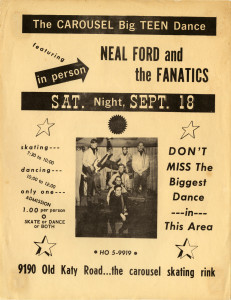
Hey all you cool cats! It’s the Carousel Big Teen Dance Saturday night down on Old Katy Road with Neal Ford and the Fanatics!
Just over a month ago, the University of Houston Special Collections kicked off their series of “Brown Bag” seminars, highlighting some of the unique work of processing and preserving research materials in our various collecting areas, as well as efforts to make these materials more accessible to interested researchers.
The first in this series, led by our Houston and Texas Archives Fellow Alison Clemens, introduced some basics of navigating the winding path of research in Special Collections and also highlighted our Texas Music Collection. Thanks to the wonders of modern technology, as well as the YouTube channel maintained by the University of Houston Libraries, those of us unable to attend the seminar can still enjoy a taste of it from the comfort of our favorite glowing screen. In the video below, both novice and experienced researchers will appreciate Ms. Clemens’s introduction to Archon, an online retrieval tool for navigating our various collections, as well as a look at how some of the materials showcased lend themselves to particular research projects or hold unique connections warranting further study.
Please enjoy the video recap along with the accompanying images below and, while you’re at it, take some time to explore the Texas Music Collection finding aid. However, if you really want to experience the Texas Music Collection, or any of our other collections under the Houston and Texas History umbrella, no amount of technology can quite replicate a visit to our Reading Room.
(All images pulled from the Texas Music Collection)
- Lightnin’ Hopkins, 1968
- Floy Tillman’s Lone Star Melodies
- Gatemouth Brown
- Alonzo y Sus Rancheros, c. 1950s
As noted recently on NPR, today marks the 125th anniversary of the publication of the classic baseball poem, “Casey at the Bat,” in 1888. One of our patrons heard the piece on the radio, and while visiting us in the Reading Room for some other research, asked if we might happen to have any materials related to this poem. A discussion ensued, and while we do not have any direct connection, a challenge was thrown down: Could we find a connection from “Casey at the Bat” to something in our archives in six steps, a la “Six Degrees of Separation”?
Well, here we go:
1. “Casey at the Bat” was written by Ernest Thayer.
2. Ernest Thayer was friends with William Randolph Hearst from their days together at the Harvard Lampoon – and Hearst later hired Thayer as humor columnist for the San Francisco Examiner, which first published “Casey” in 1888.
3. William Randolph Hearst was the inspiration for the renowned film Citizen Kane, directed by and starring Orson Welles.
4. Orson Welles exchanged correspondence with theater producer/director Cheryl Crawford; this correspondence is available right here in our archives among the Cheryl Crawford Papers.
Six degrees? Ha! We got there in four. So although there might be “no joy in Mudville,” as “mighty Casey has struck out,” we are feeling a bit victorious here in Special Collections today.
Interested researchers and visitors may view these letters and much more in our Reading Room. The bulk of the Cheryl Crawford Papers dates from 1940-1978, documenting Ms. Crawford’s career in theater through correspondence, production materials, scripts, programs, playbills, audio tapes, posters, sheet music, sound recordings, clippings, budgets, tax returns, legal agreements, contracts, audits, reviews, speeches, and miscellaneous items such as postcards and receipts.
